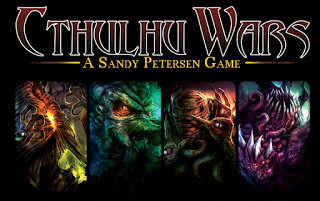So when the good folks behind Cthulhu Wars sent out a call for folks who might be interested in helping promote the latest Kickstarter, I threw my hat into the ring. So, following on the heels of my Lovecraft in Greyhawk post the other day, we’re going to start off with an interview with Ed Healy of Gamerati, who is managing the Kickstarter.
I thought it would be interesting to take the opportunity to drill into some of the mechanics of the game industry behind the curtain, and Mr. Healy was more than accommodating. This particular interview was heavy on the Kickstarter aspect of the project, but tomorrow we’ll see another with some insights about the production side. Enjoy!
 |
| Ed Healy |
Q: How many Kickstarters have you successfully managed so far?
A: I stopped counting about a year ago, so my numbers aren’t going to be 100% accurate. That said, as of July 2016, we’d helped publishers raise over $51 million dollars across over 300 projects. This includes varying amounts of advertising, PR, content marketing, strategic planning and tactical management – some more than others. We run, soup to nuts, 29 campaigns.
Q: What was your first Kickstarter? What sorts of lessons did you learn in that experience that you have applied in later campaigns?
A: We helped Erik Bauer from Gaming Paper with the Gaming Paper Adventure project back in 2010, providing advertising, PR and content marketing:
In those days, crowdfunding was very different, so I’m not sure the lessons directly apply. It was more like the Open Design projects Wolfgang Baur ran in the 2000s, where the community was helping a creator get an idea off the ground. The first big lesson I learned was on the
Lamentation of the Flame Princess Hardcover and Adventures IndieGoGo Project. Namely, that it helps when the people working on your product also have communities of their own to help increase your exposure. This is still true. I love it when an artist has 20,000 followers on Instagram or a game designer has fans on BGG. It shows they probably know how to self-promote, and you can never have too much help promoting a project.
Q: What sort of logistical challenges do you think are unique to a large board game type KS campaign like Cthulhu Wars?
A: Shipping. Hands down. It’s the most complex and terrifying aspect of crowdfunding projects. If you are only serving the USA, there are still dozens of potential shipping solutions. Add in the rest of the world and you have Customs, import duties, VAT… Shipping was one of the main reasons I killed our Loot program a number of years ago. Now, of course, we have a warehouse and 5 more years of experience. I can’t imagine launching a project that explodes without having someone on my team that understands shipping. You may recall, the original Cthulhu Wars project launched that way and Sandy Petersen mortgaged his home in order to pay all the costs they didn’t plan for.
Q: Other than the well-known issue of Chinese New Year (which I see you actually included in your project plan timeline), what sort of special considerations do you have to make when dealing with China-based manufacturing?
A: Language. Most decent manufacturers have some English-language representation. However, just because someone speaks conversational English doesn’t mean you are completely understanding each other. Americans, in particular, have different assumptions about accuracy and timelines. Don’t accept “no problem” or “okay” as answers. Yes and No are really the only thing I bank on. In writing.
Accuracy. I know I mentioned it, above, but check your math. Check your math on costs, on box dimensions and on product weights. Then check again. I have yet to work on a campaign for a game manufactured in China where there wan’t at last a half-dozen errors.
Customs. It’s not always an issue, but Customs can hold up delivery of your project by weeks. When we fulfilled the Cthulhu Wars Onslaught 2 project, much of the product was stuck in American and German Customs for more than a month.
Q: Approximately how long is your planning phase when doing a KS campaign on the same scale of a Cthulhu Wars? What goes into that planning phase?
A: If I had my way, I would have a finished “China Ready” prototype 18 months before launching a project. Sadly, I rarely do.
Most planning phases are short – days or weeks, long. For Cthulhu Wars Onslaught 3, the whole team flew to Texas and we hammered out all the main details in two days – product mix (SKUs), backer rewards and stretch goals.
After that, though, comes preparation – getting demo copies to press and maintaining media relationships, getting any additional art commissions in that are missing, working with the graphic designer to get the campaign graphics and marketing materials (ads, etc) ready.
That’s really the hard part – because, no matter what you do, someone always wants to change something during the planning phase. Usually 3 minutes before the project goes live!
Q: How do you determine stretch goals and pledge levels?
A: There’s a bit of art in there, but generally speaking:
(1) If it’s part of the core experience for the game, it’s not a Stretch Goal. It belongs in the initial offering.
(2) As much as possible, have goals that everyone can benefit from.
(3) Adding new game play content (RPG encounters or NPCs / new strategy game units or models) is always superior to ‘bling’ when it comes to Stretch Goals.
(4) Stretch Goal Pricing: Cost to product one unit of ‘the thing’ x 10 x number of expected backers = Minimum Stretch Goal ask.
(5) It’s better to run out of Stretch Goals and drop the mic at the end than to have a dozen left over that people know you didn’t make it to.
(6) Higher pledge levels should build off lower levels in some way. For instance, if they are at some premium $400 level, make sure they get everything the ‘normal backers’ get.
(7) Digital rewards, if possible, rock. They cost nothing to ship!
(8) If you have multiple similar products (RPG modules or faction expansions), have backers at one of your lower pledge levels get only one, so people can debate which one(s) the like best. Of course, use your Stretch Goals to encourage them to upgrade to those higher tiers where they get ‘all the things’.
(9) Tshirts are a bad idea. Never do tshirts.
(10) Variants make great Stretch Goals – foil cards, promos with variant art, Glow in the Dark Cthulhu!
Q: Do you think having stretch goals actually encourages people to increase their pledges, or to pledge when they might not ordinarily do so? Or are stretch goals something that are almost expected in a KS campaign nowadays?
A: Stretch Goals give you something to talk about. You get the benefit of highlighting some aspect of the game in your update about the Stretch Goal, and you have something new to post to social media – something your community can reshare to boost your signal.
When Stretch Goals are done right, they absolutely put pressure on some backers to increase their pledges. Let’s say, at the beginning of a campaign, you can get the SMECHS RPG Core Rules for $50 or you can pay $100 for everything – everything, at the start, being the core rules and the monster manual. Now lets say that you have 15 Stretch Goals that include new types of Smurfs and new types of Mechs – and every $100 backer gets those PDFs ($5.00 MSRP each) for free. For someone that really likes the idea of a Smurfs / Mechs mashup RPG, they’ll quickly feel the pressure to upgrade from $50 to $100 to get all the extra content.
Q: Do you have any advice for someone just starting on their first KS campaign?
A: Rule #1: Nothing beats making a good product. You can sell crap in a nice package once, but then you’re done. Do it right, from the start.
Rule #2: Be patient. Playtest. Edit. Then playtest 100 more times.Then edit a couple more times. You’re making a samurai sword, not a billy club.
Rule #3: Start building your community _while_ you’re making the game.
Rule #4: Advertising = Marketing ≠ Advertising (You can’t just buy some ads and think you’ve done marketing.)
Rule #5: It’s easier to sell a product when you’re telling a story, instead of selling a product.
Rule #6: Everything will be twice as expensive and take three times longer than you think it will.
Rule #7: It’s Good to be a Gamer
__________
Disclosure: I was sent a bag of Cthulhu Wars figures to use in helping boost the Onslaught Three Kickstarter (you’ll see them soon). I paid for the first Kickstarter and Onslaught Two myself, however, and will pay for Onslaught 3 when it launches Monday.










